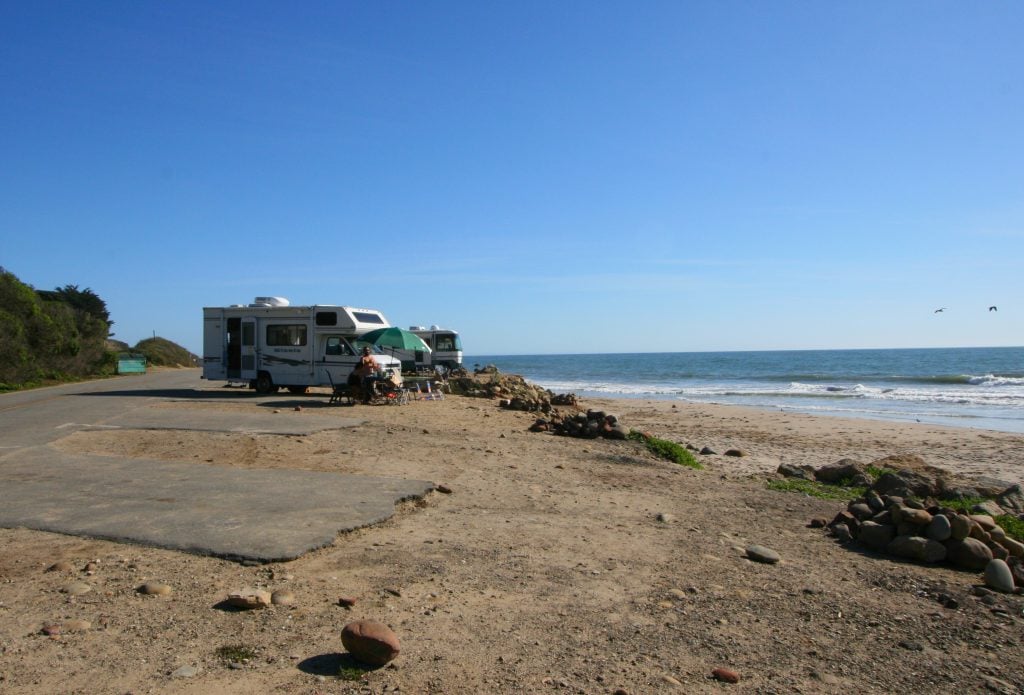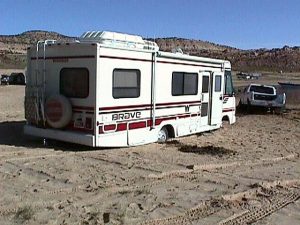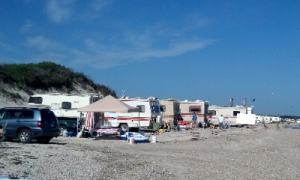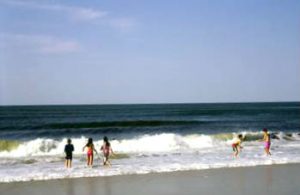In late July, when a couple parked their Class C on Brean Beach in Somerset, England, little did they realize that their day was about to get very interesting.
When the couple returned from a walk, the incoming tide surrounded the vehicle and its wheels sank deep into the sand. According to Burnham-On-Sea.com, the official website for BARB Search & Rescue, the couple didn’t realize the tide would come up so high and the vehicle was winched from the beach.
“Fortunately, the tide was not too high and the campervan could be recovered and driven away,” explained a spokesman for BARB. “However, not all motorists are that fortunate.”

Camping on the beach. Photo: Wikipedia
RVing on the beach is something every RVer can imagine. Yet campers need to realize that a beach setting—no matter where you are—is still a wilderness area. There may not be towering trees or lingering wildlife, but a sandy beach has its own series of tricky elements, which can present some challenges if you’re not ready.

A sandy beach can present challenges if you’re not ready. Photo courtesy of iRV2.com
Driving on the sand
According to Dena Bellman, Associate Park & Recreation Specialist for the Oceano Dunes District of California State Parks, RVers should first inquire at campground offices about current beach conditions. She also suggested to familiarize yourself with the beach terrain prior to driving your rig to a site.
“The best time to drive to a site is at low tide,” says Bellman. “This is when the beach provides more compact sand and is better able to support the RV. When driving on soft sand, chances are much greater of getting stuck. ”
Try the following if you do get stuck:
- Prior to driving on sand, deflate the tires of a motorhome or trailer by up to 50 percent. This spreads the tread wider to attain a better grip.
- Dig out the sand from around your tires with a shovel.
- Don’t allow your wheels to spin, this will only make the RV dig deeper into the sand.
- Place plywood or other surfaces under the tires to attain a better grip.
- Wet the sand in front of the RV to help compact the sand.
- Don’t let your vehicle get deeply buried before calling for a tow.
When maneuvering from the wet to the dry sand, small sheets of plywood (or aftermarket products) placed under the tires can be used to manoeuver into a camping spot. “Every year we see a handful of RVers who don’t put a lot of thought into this,” added Bellman. They get stuck and don’t understand why.”

RVers need to be very aware of where the tide reaches and how powerful it can be.”
Where to set up camp on a beach
Water slowly creeping up at your campsite is not a good thing. Bellman stresses that RVers need to recognize what is called “reading the rack.” This indicates the area where the tide washes up on the beach and is determined by wet, compacted sand outlined by seaweed along the shoreline.
An RVer should place themselves well above that area to camp. Simply put, parking on wet sand means you are in the path of an upcoming tide. When that happens, water starts to surround the tires, it gets sucked down into the sand, and will eventually wash the RV out to sea.
“The waves from a tide can rip an RV apart,” said Bellman. “It doesn’t occur very often but it has happened. RVers need to be very aware of where the tide reaches and how powerful it can be.”

Always park your RV with the doors away from the ocean.
How to set up a proper campsite on the beach
It seems ideal to park your RV facing the water, when in fact this is not the greatest idea. According to Bellman, most RVers park their RV with the doors away from the ocean to deflect wind. This position also prevents wind from blowing directly at the canopy, which, in turn, can potentially cause damage (as well as parts other parts of the unit were the canopy attaches).
Other parking tips include:
- Place plywood (or another solid surface) underneath leveling jacks (or even tires) to prevent sinking in the sand.
- Set up mesh, plastic or plywood sheets against your ocean-facing walls of your RV. This blocks sand from blowing out from underneath the tires, which causes the RV to tilt and get stuck.
- Always use large mats at your campsite to help keep sand out of your RV.
Watch the weather and visit during ideal seasons
No matter where you visit, every region has a season or two when the weather is unpredictable. Bellman explained that RVers shouldn’t make beach camping a priority during windy seasons.
“What happens is the tide comes up and makes the sand wet. Then when the wind picks up it blows all the sand, scatters it, and makes it softer. What is also challenging is the sand scours out around everything when in windy conditions, such as the wood blocks, jacks, tires, and this is when RVs get stuck.”

Always be aware when tides take place.
Understanding tides
While you don’t have to be a meteorologist or learn everything there is to know about tides, it is important to know when they take place. While NOAA ceased printing and distributing its annual Tide Tables and Tidal Current Tables, current tide tables are now being printed and distributed under license through several publishers for your reference.
“Tides are different at every location,” says Bellman. “However, they take place twice a day with two low tides and two high tides. They are also approximately 12 hours apart. RVers must also realize that certain storms can cause surges, which can push the tide up higher than what might be expected. There are also sweepers, which can bring the waves even higher up on the beach. RVers need to pay attention and make sure they are camped high enough to avoid the tides.”

There are smartphone apps for tide information. I use Tides.
We have taken our fifth wheel trailer to Oceano Dunes in California for many years and pull out an average of 3 rv/4 wheelers every day. You need to take your tires down to around 20# for both the rv. and vehicle. You will need sheets of wood or plastic to cover the lower side of your rv. and tall stakes to hold them up. This will protect the underside of the rv from blowing sand. Bring a tow strap should you need to get pulled out or help pull someone else get pulled out.
Drive slowly and don’t stop until you get your t.v. placed as you don’t want to get stuck. Then enjoy your stay.
How about helpful tricks & tips to keep sand out of the vital working parts of your RV? Does the blowing sand get into the heating and air systems, engine air filters, vents for refrigerators, propane vents, slide mechanisms, etc. Are there ways to keep some or all of the sand out of your rig?
Another suggestion I would make is to retract any automatic entry steps. Blowing sand can especially infiltrate the slides when extended. That makes a gritty mess that can ultimately ruin the bearings inside, and can cost over a thousand dollars to mitigate.
Keep the steps retracted and use a portable fold-up step for entry instead.